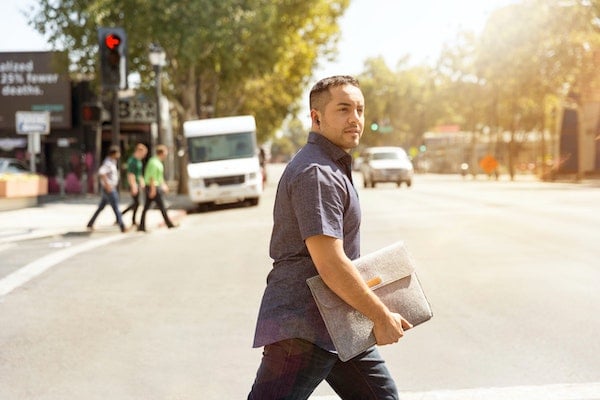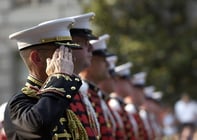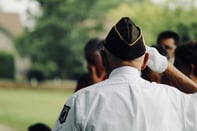Published on
Four Ways Institutions Can Increase Student Veterans’ Sense of Belonging on Campus

More than two million student veterans have enrolled in colleges and universities since August 2009, and 96% of higher education institutions enroll student veterans (Institute for Veterans and Military Families & Student Veterans of America & Student Veterans of America, 2019). Yet, research continues to show that student veterans are less likely to view themselves as part of a campus community than civilian students (Barry et al., 2019). These findings are important to understand because students’ sense of belonging in higher education affects key success factors such as persistence and attainment (Strayhorn, 2012).
The American Institutes for Research, in collaboration with the Student Veterans of America, conducted a study on the postsecondary experiences of student veterans, which sought to understand factors that impact student veterans’ sense of belonging at their institutions. One goal of the study was to understand the extent to which recognition of student veterans’ prior experiences, including their military learning and training, impacted student veterans’ feelings of belonging on campus. Our findings reveal four common factors that help foster a sense of belonging on campus for student veterans, and the following suggestions include steps that postsecondary institutions can take to foster student veterans’ sense of belonging on campus:
1. Leverage student veterans’ experiences as nontraditional adult students
Student veterans are likelier to be older and married with different life experiences than traditional students. In our study, many student veterans described being their own advocates in overcoming the initial transition from the military to college. Many student veterans felt more integrated by getting involved in campus life. For example, student veterans said they joined teams or clubs and attended sporting events. Furthermore, student veterans often felt a sense of pride in overcoming challenges and the resulting self-efficacy. For example, some veterans noted that they did not need “hand holding.” This finding is not meant to suggest that student veterans should be left to do all the work of integrating into campus themselves but that the supports they need are likely different from those traditional student need, and institutions should consider structuring supports accordingly. Academic advisors should be aware of the unique experiences of student veterans and equipped with the tools to empower student veterans to make informed decisions related to their postsecondary educational experiences. Institutions can help by ensuring academic advisors are provided with training and resources on how to support student veterans as they transition from the military to campus.
2. Support student veterans’ transitions to campus by fostering connections with campus organizations and resources
The transition from the military to postsecondary education is difficult, and our findings suggest this phenomenon has a negative impact on student veterans’ sense of belonging on campus. For example, some student veterans described struggling initially with the lack of structure at postsecondary institutions. Others described struggling to find an identity outside of the military because they found it difficult to connect with nonmilitary peers and campus organizations. Institutions can help mitigate the challenges associated with transitioning from the military to postsecondary education by providing on-campus structures and supports tailored to student veterans, such as providing mental health services and connecting student veterans with staff who have knowledge of veterans’ issues.
3. Support veterans’ organizations on campus
Our findings support existing research about the importance of student veterans’ organizations (SVOs) on campus. Many student veterans reported gravitating toward campus SVOs, which were often described as positively affecting sense of belonging through various academic and nonacademic supports. For many student veterans, SVOs became a place to foster community and find other students with similar experiences. One student veteran said, “When you get out of service, even if you wanted or not to be identified as a veteran, you still have somewhere to go with people with very similar experiences. At least they understand where you come from and what you’ve done…Just being in the same room can be really nice.”
4. Educate nonveteran students, faculty and staff about inclusive practices related to student veterans
Findings from our study show that staff and faculty who are well informed about student veterans can be key facilitators to ensuring their success. However, many student veterans described how negative views of the military expressed by peers, faculty and staff made them feel unwelcome. For example, one student veteran described how faculty were often “not familiar with . . . military culture, or that it even has its own culture worthy of recognition.” Many student veterans described finding it difficult to connect to nonveteran students who were often younger and couldn’t relate to their types of experiences. Our findings suggest that acknowledging student veterans through gestures such as Veterans Day or offering student veterans priority registration can help them feel more welcome on campus. In addition, campuses could ensure that efforts to increase diversity and inclusion consider student veterans.
These early findings and lessons learned are based on focus groups with student veterans conducted in 2020. An upcoming report in spring 2021 will include findings from a nationwide survey of student veterans and will delve deeper into student veterans’ experiences–in particular, those of student veterans of color. To learn more about the study, please visit https://www.air.org/project/informing-improved-recognition-military-learning.
References
Barry, A. E, Jackson, Z. A., & Fullerton, A. B. (2019). An assessment of sense of belonging in higher education among student service members/veterans. Journal of American College Health. https://doi.org/10.1080/07448481.2019.1676249
Institute for Veterans and Military Families & Student Veterans of America. (2019). Student veterans: A valuable asset to higher education. Syracuse University. https://ivmf.syracuse.edu/wp-content/uploads/2019/12/Student-Vets_Valuable-AssetFINAL-11.6.19.pdf
Strayhorn, T. L. (2012). College students’ sense of belonging: A key to educational success for all students. Routledge.
Disclaimer: Embedded links in articles don’t represent author endorsement, but aim to provide readers with additional context and service.
Author Perspective: Analyst



